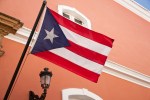Cristina Vázquez-O’Neill sat cross-legged on the marble floor outside Puerto Rico’s Capitol Building in Old San Juan on Friday, shielding herself from the intensity of the afternoon sun with a message written on white poster board: “4,645 deaths and papi was one.” The 22-year-old University of Puerto Rico student mourned with her brother and alongside hundreds of others who brought shoes to represent those who perished as a result of Hurricane Maria.
Row after row was added as people laid down individual pairs, some with names or notes of indignation for the government’s culpability in the crisis that followed.
The demonstration was organized in response to a Harvard study released Tuesday that estimates 4,645 additional deaths in the three months after the storm. Doubts have surrounded the official death toll, still officially at 64, for months. Puerto Rico’s Center for Investigative Journalism filed a lawsuit in February against the director of the Puerto Rico Demographic Registry “after multiple attempts to get the agency to offer information about the deaths that occurred on the island,” but a May 21 court date did not provide immediate answers.
In the evening, as the count of shoes reached one thousand, that office finally released updated numbers, which indicated 1,451 more deaths from September through November than the year prior.

While the Harvard Study revealed its estimate based on a survey of 3,299 households, Vázquez-O’Neill believes the real number is likely higher.
Her family waited out the hurricane together. A few days later, Vázquez-O’Neill father left to review potential damage to his own home in Carolina. Communication was obsolete at the time, but eventually she began to worry; they’d never gone more than three days without checking in with each other.
“I had to go to his house, and I found him dead,” she tells me. “He was a diabetic; he had high blood pressure. Definitely it was the whole situation that transpired in that week after the hurricane – it was chaos. Two weeks before that we had celebrated his birthday. He was in good health.”
She has yet to learn the exact circumstances of her father’s death; medical examiners couldn’t perform an autopsy because “there were so many cadavers,” Vázquez-O’Neill adds. Draped in a Cuban flag representing his native country, she sniffled, then noted he had been a supporter of Rosselló.
“I’ve asked myself sometimes, how many people of all those who died voted for the governor, and put their confidence in him and his call for transparency? It’s very rough,” she says. “The government is turning its back on us. They’re ripping the country apart.”
Her grandmother, she adds, was briefly hospitalized following the storm. She recuperated, but “a lot of people died right there in the emergency room. That says a lot.”
On the opposite side of the memorial, Luis Torres and Fabiola Santiago, both in their early 20s, stood in solidarity. They’d traveled from the municipality of Bayamón by Uber, train, and bus to arrive in Old San Juan.
“[This is] a tragedy that shouldn’t have happened. With adequate preparation and an efficient government, we could have avoided the greater part of those deaths,” Santiago says. “I think that, as a citizen of this country, as part of this community, it’s my duty to at least be here and pay my respects to all these people, to the families of these people. Because we’re all family, we’re all part of something.”
Illnesses directly related to the storm, including the bacterial disease leptospirosis, and complications resulting from a lack of access to services (like dialysis treatment for kidney disorders and insulin for diabetics), are among the causes of deaths post-storm. A surge in suicides was also reported – a 29 percent increase in 2017 compared to 2016 numbers.
Along the road outside the Capitol Building, an elderly woman named Helga handed out paper signs bearing the number 4,645 in thick, black letters, with a black ribbon above. Drivers in passing cars stopped to collect, as did many people present at the memorial. She conveyed her disappointment in the Puerto Rican government’s failure to acknowledge and recognize the reality of the storm-related deaths.
In a press conference on Tuesday, Rosselló said he welcomes the Harvard University survey, admitting that the official count is a “substantial underestimate.” The governor pointed out that his administration is waiting for its own report from George Washington University, which it commissioned in February. People have used social media to convey their concerns about a potential bias. So far, the University has received $300,000 for the independent study. Additionally, Puerto Rico’s Secretary of Education, Julia Keleher, is an adjunct faculty member of the university’s business school, and Rosselló’s father, Pedro Rosselló, was aSenior Associate of its Global Health Department after his term as governor of Puerto Rico ended in 2001.
The likelihood that the numbers will be truthfully reported has been questioned, as deaths certified as related to Hurricane Maria could qualify for federal aid.




